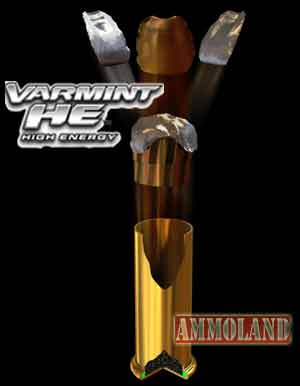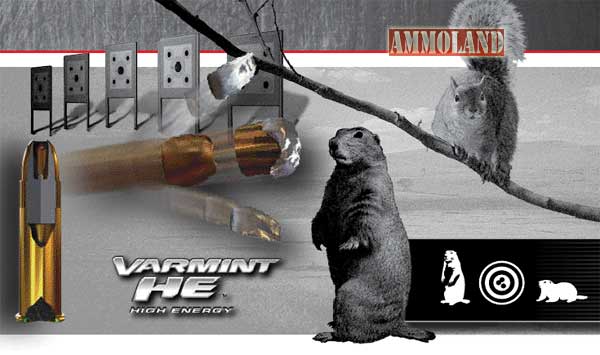By J. Guthrie

East Alton, IL – -(Ammoland.com)- Much like dropping a big caddie engine under the hood of a beat-up Ford for a county line moonshine run, loading your dusty, sometimes rusty, rimfire truck gun with Winchester’s new rimfire offerings is a great way to squeeze more horsepower out of that tried-and-true varmint gun.
Winchester’s rimfire lineup has expanded in the past few years to include some snazzy new bullets and improved ballistics.
There are probably more than a few shooters out there who would not consider using a rimfire for varmints in the first place, but the little cartridges can get the job done and even have a few advantages over their centerfire big brothers. Rimfire varmint rifles have not equaled the distances reached by heavy-barreled rifles chambered for the screaming .22-250 or even the mild .204 and .223, but a six-pound rimfire is certainly handier than a 14-pound, heavy-barreled rig when crawling up on a groundhog or riding the range in a pickup. Compact and easier to tote, it is more likely to be in your hands when that varmint makes a break for the next county.
Cost is another huge factor. Even the most expensive box of premium rimfire ammo can be bought with change under your couch cushions while a good centerfire varmint ammunition starts at almost $1 per round. You simply end up shooting more with a rimfire because it is so ridiculously cost-effective.
Combine that with the ability to call your own shots because of the lack of recoil and greatly reduced blast and noise and a rimfire makes sense as an everyday varmint rifle.

Segmenting Innovation
The .22 LR is the world’s most popular cartridge by far and has accounted for countless varmints. Introduced last year, Winchester’s Varmint HE 3/1 segmenting bullet is a serious little round that will help varmint hunters account for more.
It is probably the most devastating bullet ever to be stuffed into a Long Rifle case.
The 37-grain slug is propelled to a speedy 1,435 fps in standard-length rifle barrels, but it is the bullet that makes it a dramatic performer. What looks like an ordinary, copper-plated hollowpoint is actually a high-tech bullet that is programmed to break into four pieces when it strikes a target.
Three segments surrounding the hollow-point immediately break off on impact, dumping energy and creating their own wound channels as they go. The segments average four to five grains each. The bullet’s base, which averages 22 to 25 grains after separating from the top-side pellets, continues to drive deep for excellent penetration.
Winchester tested the new Varmint 3/1 extensively in ordnance gelatin and got three inches of penetration out of the segments and six to nine inches out of the base. This makes the Varmint HE an ideal round for varmints of almost any size.
Great .22 LR varmint loads are certainly not limited to the 3/1. Winchester has close to two dozen other .22 LR rounds, most of which will work just fine for shooting varmints.
Hollowpoint designs will probably prove the most effective because of their ability to rapidly dump energy in a critter, and it makes a lot of sense to stick with bullets that wear the Lubaloy coating to reduce fouling.
Rimfire rifles are notoriously sensitive to ammo, so it may take four or five boxes of different bullet types and velocities to finally settle on something your rifle really likes. One of my favorite .22 rifles fancies the Winchester 555 bulk pack. I can get 555 rounds for just $25, but the 36-grain JHP is exceptionally accurate.
If you wanted to add 100 yards to the .22 LR’s maximum effective range of 75 or 100 yards or shoot bigger critters, just step up to the .17 HMR or .22 Win Mag. While my personal bias usually leans toward the scorching little 17-caliber wonder, both cartridges are big performers on varmints.
I’ve shot everything from ground squirrels to jackrabbits to coyotes with both calibers out to 200 or so yards. Choosing between the two has become harder over the years. After its introduction in 2002, there were just a few rifles and loads available for the .17 HMR. The two cartridges have now reached parity in terms of available rifles, but the .22 Win Mag far outstrips its progeny when it comes to ammo choices. If you are looking for something special, the .22 Win Mag probably has it, while there are just a few bullet weights and types for the .17 HMR.

A Case For .17 HMR
But here is the case for the HMR from a fellow who loves speed. With a 100- yard zero, a 17-grain bullet is just 8½ inches low at 200 yards.
The .22 Win Mag with a similar bullet weighing 30 grains is 16½ inches low. The 17 produces a few more foot-pounds of energy at that extended range by virtue of its retained velocity. The wind is going to play havoc with both bullets, though it is obvious the .22 Win Mag has a slight advantage in this department.
Given that most of my off-the-cuff varmint shooting is done without the aid of a laser rangefinder, I really like the flat flight profile of the .17 HMR.
Aiming slightly over most prairie dogs at extended ranges will result in a solid thwack inside of 200 yards.
And what’s more, Winchester has recently improved its .17 HMR shell case. A stronger shoulder results in improved case integrity, and more efficient powders are resulting in reduced pressures and more consistent velocities. Finally, Winchester has beefed up the rim for more head strength…it’s manufacturing excellence from an industry leader.
Pairing rimfire loads with a BDC reticle-equipped scope makes the whole operation that much faster and deadlier. I have a Nikon Prostaff Rimfire affixed to my favorite .17 HMR bolt rifle, and its little circles allow me to get on target out to 200 yards in the blink of eye. Be sure that the equipment surrounding the ammo helps, not hinders.
Under the Winchester Varmint HV moniker, both calibers are available with a V-Max bullet—17 grains for the .17 HMR and 30 grains for the .22 Win Mag—which gives improved ballistic performance over the old lead, round-nose bullets. Its explosive terminal performance inside 100 yards is on par with any of the hollowpoints currently available.
There are times when the .22 Win Mag, loaded with a heavier bullet, has its day in the sun. In my home state of Georgia, hunting hogs or coyotes with a centerfire rifle during small-game seasons is prohibited on wildlife management areas.
There is excellent hog and coyote hunting on WMAs, and you have the added advantage of not competing with or disturbing deer hunters during these small-game-only seasons. While the .17 HMR has plenty of juice for any coyote that roams this fine state, having an extra 20 or so grains of insurance when stalking a big hog is a wonderful thing, even when you are limited to head shots.
Winchester also recently introduced Varmint HE load in its Win Mag lineup. Just like the aforementioned .22 LR Varmint HE load, the 34-grain, segmented bullet screams along at 2,120 fps. Of all the Win Mag loads in the catalog, it produces the most energy.

Lead-Free Options
Quite a few dedicated varmint shooters now live in areas [right or wrong] where lead bullets are illegal. This new regulation forced many to sideline their rimfires for lack of ammunition that met the new requirements. Winchester answered the call and now offers three lead-free bullets in .22 LR, .17 HMR, and .22 Win Mag.
The bullets —some copper, some tin— are probably the fastest rimfire rounds on the store shelf because of their light-for-caliber weights. Highway patrolmen are not joking when they say “speed kills,” so a 26-grain JHP traveling at 1,650 fps should get a varmint’s undivided attention. The .22 Win Mag load develops 2,200 fps, and the .17 HMR NTX comes in at a fairly standard 2,550 fps despite a bullet weighing only 15.5 grains. (The NTX does have a polymer tip in its nose to improve external ballistics.)
Rimfires, despite their diminutive size, are big performers on varmints large and small. In tight quarters, their reduced report and risk of over- penetration is a huge plus, not to mention the tremendous cost savings over the cheapest centerfire ammo.
Winchester’s bullet advances and numerous loads make any rimfire from the stalwart .22 LR to the über-cool .17 HMR a contender for the perfect varmint-killing tool.
About Winchester Ammunition
With a company heritage dating back to 1866, Winchester Ammunition was there for the taming of the American West, the Allied Forces’ victory in World War II and through the years, millions of fond memories made in the great outdoors. Known as The American Legend, Winchester is a global leader in sporting, law enforcement, military and personal defense ammunition production. Winchester continues to raise the bar with new products like Blind Sider waterfowl and PDX1 Defender personal defense ammunition. For more, visit Winchester.com.

